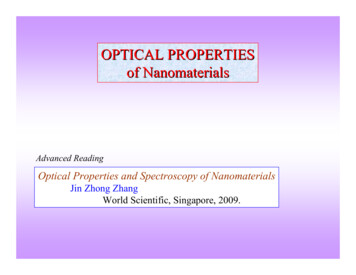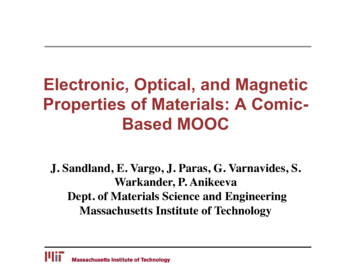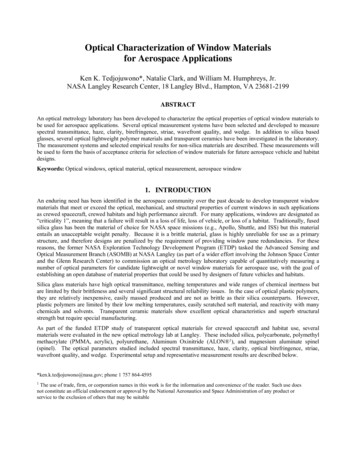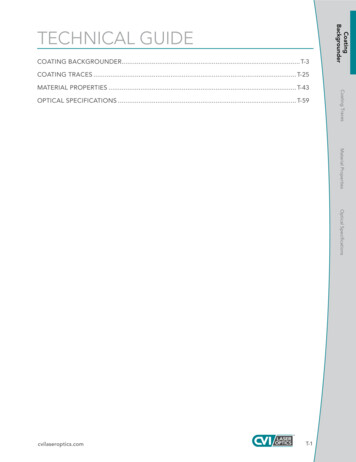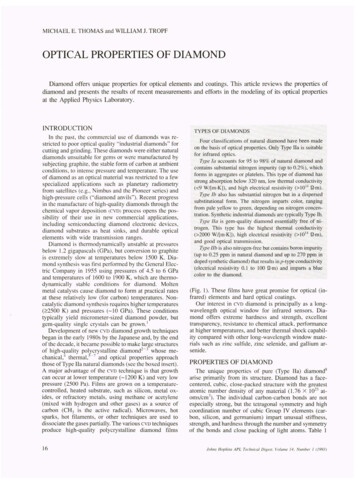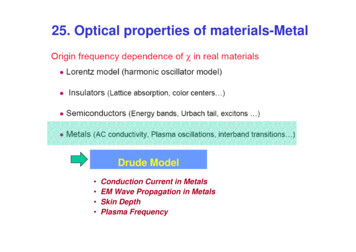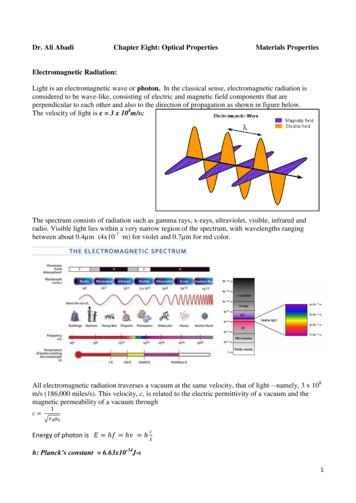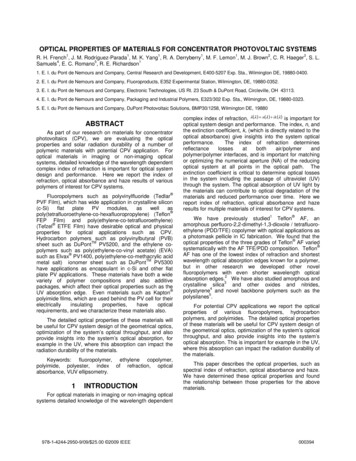
Transcription
OPTICAL PROPERTIES OF MATERIALS FOR CONCENTRATOR PHOTOVOLTAIC SYSTEMS1111123R. H. French , J. M. Rodríguez-Parada , M. K. Yang , R. A. Derryberry , M. F. Lemon , M. J. Brown , C. R. Haeger , S. L.451Samuels , E. C. Romano , R. E. Richardson1. E. I. du Pont de Nemours and Company, Central Research and Development, E400-5207 Exp. Sta., Wilmington DE, 19880-0400.2. E. I. du Pont de Nemours and Company, Fluoroproducts, E352 Experimental Station, Wilmington, DE, 19880-0352.3. E. I. du Pont de Nemours and Company, Electronic Technologies, US Rt. 23 South & DuPont Road, Circleville, OH 43113.4. E. I. du Pont de Nemours and Company, Packaging and Industrial Polymers, E323/302 Exp. Sta., Wilmington, DE, 19880-0323.5. E. I. du Pont de Nemours and Company, DuPont Photovoltaic Solutions, BMP30/1258, Wilmington DE, 19880ABSTRACTAs part of our research on materials for concentratorphotovoltaics (CPV), we are evaluating the opticalproperties and solar radiation durability of a number ofpolymeric materials with potential CPV application. Foroptical materials in imaging or non-imaging opticalsystems, detailed knowledge of the wavelength dependentcomplex index of refraction is important for optical systemdesign and performance. Here we report the index ofrefraction, optical absorbance and haze results of variouspolymers of interest for CPV systems. Fluoropolymers such as polyvinylfluoride (TedlarPVF Film), which has wide application in crystalline silicon(c-Si)flatplatePVmodules,aswellas poly(tetrafluoroethylene-co-hexafluoropropylene) (TeflonFEP Film) and poly(ethylene-co-tetrafluoroethylene) (Tefzel ETFE Film) have desirable optical and physicalproperties for optical applications such as CPV.Hydrocarbon polymers such as polyvinylbutyral (PVB)TMsheet such as DuPont PV5200, and the ethylene copolymers such as poly(ethylene-co-vinyl acetate) (EVA) such as Elvax PV1400, poly(ethylene-co-methacrylic acidTMPV5300metal salt) ionomer sheet such as DuPonthave applications as encapsulant in c-Si and other flatplate PV applications. These materials have both a widevariety of polymer compositions and also additivepackages, which affect their optical properties such as the UV absorption edge. Even materials such as Kaptonpolyimide films, which are used behind the PV cell for equirements, and we characterize these materials also.The detailed optical properties of these materials willbe useful for CPV system design of the geometrical optics,optimization of the system’s optical throughput, and alsoprovide insights into the system’s optical absorption, forexample in the UV, where this absorption can impact theradiation durability of the materials.Keywords: fluoropolymer, ethylene copolymer,polyimide, polyester, index of refraction, opticalabsorbance, VUV ellipsometry.1INTRODUCTIONcomplex index of refraction, nˆ (λ ) n(λ ) ik (λ ) is important foroptical system design and performance. The index, n, andthe extinction coefficient, k, (which is directly related to theoptical absorbance) give insights into the system opticalperformance.The index of refraction ymer/polymer interfaces, and is important for matchingor optimizing the numerical aperture (NA) of the reducingoptical system at all points in the optical path. Theextinction coefficient is critical to determine optical lossesin the system including the passage of ultraviolet (UV)through the system. The optical absorption of UV light bythe materials can contribute to optical degradation of thematerials and reduced performance over time. Here wereport index of refraction, optical absorbance and hazeresults for multiple materials of interest for CPV systems.1 We have previously studied TeflonAF, anamorphous perfluoro-2,2-dimethyl-1,3-dioxole / tetrafluoroethylene (PDD/TFE) copolymer with optical applications asa photomask pellicle in IC fabrication. We found that the optical properties of the three grades of Teflon AF varied systematically with the AF TFE/PDD composition. TeflonAF has one of the lowest index of refraction and shortestwavelength optical absorption edges known for a polymer,but in other research we developed other novelfluoropolymers with even shorter wavelength optical2absorption edges. We have also studied amorphous and3and other oxides and nitrides,crystalline silica4polystyrene and novel backbone polymers such as the5polysilanes .For potential CPV applications we report the opticalproperties of various fluoropolymers, hydrocarbonpolymers, and polyimides. The detailed optical propertiesof these materials will be useful for CPV system design ofthe geometrical optics, optimization of the system’s opticalthroughput, and also provide insights into the system’soptical absorption. This is important for example in the UV,where this absorption can impact the radiation durability ofthe materials.This paper describes the optical properties, such asspectral index of refraction, optical absorbance and haze.We have determined these optical properties and foundthe relationship between those properties for the abovematerials.For optical materials in imaging or non-imaging opticalsystems detailed knowledge of the wavelength dependent978-1-4244-2950-9/09/ 25.00 2009 IEEE000394
22.1used for longer wavelengths. Ellipsometric measurementswere conducted using light incident at angles of 65 to 75 relative to normal on the front surface of the sample, theback of which was roughened with coarse polishing paper.EXPERIMENTAL METHODSMaterialsFluoropolymers (FP): Films of tetrafluoroethylene hexafluoropropylene copolymer (Teflon FEP 500A), ethylene-tetrafluoroethylene copolymer (Tefzel ETFE 500LZ), and polyvinylfluoride (Tedlar PVF TR10AH9 andUT20BG3) were obtained from DuPont Fluoroproducts.The use of these materials in conventional PV modules is6well documented . Hydrocarbon polymers (HCP): DuPont PV5200 PVB and DuPont PV5300 Ionomer sheet and ElvaxPV1400 resin were obtained from DuPont Packaging andIndustrial Polymers. Films of different thickness weremade by melt pressing. Polyimides (PI): Kapton H; Kapton HN and Kapton E; were obtained from DuPont ElectronicTechnologies.Since the results of the haze measurement vary withthe film thickness, we include in Table 1 the thicknesses ofthe samples used for Haze measurements.Table 1 Sample thickness (t) in mils (0.001”). FPtHCPtPIt2.2TedlarPVFUT20BG32PV1400EVA10 Kapton H2 Tedlar TefzelPVFETFETR10AH912PV5200PVB10 Kapton HN2and , which are defined by Equation 18,tan (Ψ )e i RPRSΨ(1)where RP/RS is the complex ratio of the p- and s-polarizedcomponents of the reflected amplitudes.These9parameters are analyzed using the Fresnel equations in acomputer-based modeling technique including a surfaceroughness layer to directly determine the optical10,11 constants.VUV-VASEVU-302 measurements forthis experiment were taken from wavelength range 145 nmto 1650 nm and at multiple angles of incidence (65 – 75 ).Variable angles improve confidence, as light travelsdifferent paths through the film.The ellipsometry data, taken from the film, was fit todetermine the polymer film roughness, thickness non12uniformity, and complex refractive index.An opticalmodel was used to describe the film optical constants overthe wide spectral range. Teflon FEP2PV5300Ionomer10 Kapton E2Spectroscopic EllipsometryVariable angle spectroscopic ellipsometry (VASE) measurements were performed with a VUV-VASE VU7302 instrument by J. A. Woollam Co. , which has a rangefrom 0.69 to 8.55 eV (1800 to 145 nm), and employs MgF2polarizers and analyzers rather than the more commoncalcite optics. The spectrometer was upgraded fromsingle beam to dual beam for more accurate transmissionmeasurements and better instrument stability.Theinstrument has a MgF2 auto-retarder and is fully nitrogenpurged to avoid absorption of VUV light by ambientoxygen and water vapor which is important at wavelengthsbelow 200 nm. Light from both the deuterium lamp andthe xenon lamp passes through a double-chamberCzerny-Turner type monochromator to provide wavelengthselection and stray-light rejection. The spot diameter oflight source on the surface of the sample is 2 mm.Computer-controlled slit widths can adjust the bandwidthto insure adequate spectral resolution of optical features inthe data such as the closely spaced interferenceoscillations, which arise in very thick film.Aphotomultiplier tube is utilized for signal detection in theultraviolet. A stacked Si/InGaAs photodiode detector is978-1-4244-2950-9/09/ 25.00 2009 IEEEThe instrument measures the ellipsometric parametersThe film is modeled using tabulated optical constantsfrom Woollam. A thin surface layer was described in theoptical model using roughness, which is an effectivemedium approximation (EMA) consisting of 50/50 mix oforganic film and void (n 1). In the initial stage a Cauchydispersion model was used to fit the transparent region of450 nm to 1550 nm. Then the model was determined byfitting the optical constants on a point-by-point basis overthe full spectral range in which the data in each singlewavelength are fit separately. Finally the n and k areTMmatched and the data is fitted using a Genosc layer13(Equation 2) .nˆ n ik2.3(2)Optical Absorbance and HazeThe optical absorbance was determined by centermount absorbance method (Figure 1) using a Cary 5000UV-Vis-NIR spectrophotometer (Varian) for free standingfilms. The measured value of absorbance was divided bythe film thickness to obtain a value of optical absorbanceper cm (base 10).Figure 1. Center mount absorbance method.000395
For films coated on a substrate, once the transmissionspectra of the film were determined, the film’s opticalabsorbance per cm (base 10) could be determined byA / cm log [Tsubstrat / Tfilm ]10tfilm(3)where T is the transmission and t is the thickness of thefilm and A/cm is the absorbance per centimeter. Usingmultiple samples of different film thickness one can thensolve the resulting system of equations and determine thereproducibility and a standard deviation of the opticalabsorbance per centimeter.The calculation of optical absorbance assumes thatthe film is of homogenous composition and uniformthickness. Therefore an integrating reflectance accessoryis required and the reflectance measured is predominately14Transmission based measurements alsospecular .require that the film thickness of the sample on thesubstrate be optimized for the dynamic range of thetechnique so that the transmittance of the film falls in therange from 3 to 90%. If the transmittance falls muchbelow 1%, the accuracy of the measurement is severely15degraded and erroneous results appear .The Cary 5000 UV-Vis-NIR spectrophotometer(Varian) is also used for the haze measurement. TheTable 2 Index of refraction (n) at d-line (589.3nm). TedlarTedlar Index1.4891.4801.487 PIKapton HKapton HNKapton EIndex1.8241.8171.899instrument utilizes a hemispherical optical measuringsystem, with an integrating sphere, in which the specimenis placed flush against the sphere port. A unidirectionalillumination with diffuse viewing geometry was used. Thetransmission (total and scattered) and reflectance (diffuse specular and diffuse only) (defined in Figure 2) weremeasured based on ASTM D 1003 procedure B (Figure 3).The following Equation was used to calculate the percenthaze:Haze Td / Tt X 100(4)Where Td is the diffuse transmittance and Tt is the totaltransmittance.The above measurements were conducted under thefollowing conditions: The external DRA-2500 was installedinto the spectrophotometer and aligned. UV-Vis-NIRspectra were, in general, acquired in the region 200-2500nm using appropriate baseline correction (zero/baselinefor %T and absorbance, zero x standard reference forreflectance, correction for spectral only).Indicativeinstrumental parameters were as follows: spectral978-1-4244-2950-9/09/ 25.00 2009 IEEEbandwidth (SBW): 4 nm; averaging time: 0.4 sec; datainterval: 2nm; double beam mode using full slit height for%T and absorbance, reduced for %R; a mask over thesample port was used with a reduced slit for thereflectance data; the mask is in place during baseline andsample collection; NIR energy: 75 – 100; a small spot kit(SSK) was used for the center mount absorbance data(not reflectance).Figure 2. The components of the Total Transmittanceand Total Reflectance.Figure 3. ASTM D 1003 procedure B for Hazemeasurement utilizing unidirectional illumination withdiffuse viewing geometryAs in all experimental measurements, the accuracy ofthe measured values is a function of the sample andmeasurement apparatus.The inherent sensitivity ofspectral transmission and absorbance measurements isaffected by the optical path length of the sample, and thetransmission drop that occurs as light transmits throughthe sample. As the transmission drop decreases, theaccuracy of absorbance measurement decreases. Atransmission difference of 0.1% is near the limit of themeasurement method.3RESULTS AND DISCUSSIONNow we present results on the spectral index ofrefraction (Table 2), the absorbance per centimeter andthe haze of the materials of interest. The refractive index(n and k) and transmission intensity of materials ofpotential interest to CPV were determined over thewavelength range 145 nm to 1650 nm.000396
3.1Fluoropolymers (FP)3002503.1.1 Index of Refraction200Abs/cmThe index of refraction versus wavelength for thefluoropolymers studied is shown in Figure 4. Their valuesat the sodium D-line are also summarized in Table 2. The lowest index of refraction corresponds to Teflon FEPwhich is a completely fluorinated material. As the amountof fluorocarbon decreases in the other polymers the index increases as expected. Tefzel ETFE is an approximatelyalternating copolymer of ethylene and tetrafluoroethylenewhich results in a fluorine content of about 59 weight percent. Tedlar PVF has the lowest fluorine content of thethree at 41 weight %.FP150Tedlar UT20BG3Tedlar TR10AH9100Tefzel ETFETeflon Wavelength (nm)Figure 5. Optical absorption of fluoropolymer films1.850FP40Tedlar UT20BG31.6Tedlar TR10AH9Tefzel ETFETeflon FEPHaze%Index of refraction "n"1.71.5FP30Tedlar UT20GB3Tedlar TR10AH9Tefzel ETFETeflon FEP201.4101.3150350550750950115013501550Wavelength (nm)0380Figure 4. Index of refraction n determined fromellipsometric data for fluoropolymers.These fluoropolymers exhibit normal dispersion,defined as the fact that the index of refraction is seen toincrease as the wavelength decreases, down towavelengths below 200 nm.Normal dispersion isobserved as the wavelength of the light approaches the16fundamental absorption edge.580680780Wavelength (nm)Figure 6. Haze of fluoropolymer films3.2Hydrocarbon Polymers (HCP)Hydrocarbon polymers such as the ethylene copolymerswith vinyl acetate are widely used as encapsulants in PV.1.953.1.2 Abs/cm & Haze:1.85Index of refraction "n"The Abs/cm and haze of the fluoropolymers areshown in Figure 5 and Figure 6 respectively.The fundamental absorption edge of Teflon FEP and TefzelETFE is at wavelengths below 200nm and therefore the Abs/cm is very low at all solar wavelengths. Tedlar PVFTR10AH9 film shows an absorption edge below 300 nm while Tedlar PVF UT20BG3 film essentially blocks mostradiation at wavelengths below 400 nm. Its Abs/cm athigher wavelengths is still very low and comparable to theother fluoropolymers. Even though all the fluoropolymersstudied here are semicrystalline materials, only films of Tedlar PVF UT20BG3 exhibit significant haze. Teflon FEP, Tefzel ETFE and Tedlar PVF TR10AH9 films arevery clear and show much less haze than that one UVopaque Tedlar 50550750950115013501550Wavelength (nm)Figure 7. Index of refraction n determined fromellipsometric data for hydrocarbon polymers .3.2.1 Index of RefractionTheir index of refraction versus wavelength is shownin Figure 7. All of them have very similar index over the978-1-4244-2950-9/09/ 25.00 2009 IEEE000397
wavelength range measured. PV1400, a copolymer ofethylene and vinyl acetate commonly used in encapsulantformulations for flat plate c-Si PV, shows a slightly higher index than the other two.DuPontPV5200,polyvinylbutyral commonly used in thin-film PV, has thelowest index of refraction.3.2.2 Abs/cm & HazeThe absorption and haze of the hydrocarbon polymer samples are shown in Figure 8 and Figure 9. ElvaxPV1400 is an unformulated ethylene-vinyl acetate resin. Itdoes not contain any UV stabilizing additives and thereforeshows a shorter wavelength absorption edge than the DuPont PV5200 PVB and DuPont PV5300 ionomerencapsulants, which are fully formulated products. In addition, Elvax PV1400, and DuPont PV5200 PVB exhibit some haze at these film thicknesses. DuPontPV5300 ionomer films are very clear and have the lowesthaze of all these encapsulants.therefore screened from direct sunlight. However, theiroptical properties are still of interest for other potentialapplications in the PV industry.3.3.1 IndexFigure 10 shows the index of refraction versuswavelength for three different polyimides. As expected ofpolymers with an aromatic backbone, the index ofrefraction is much higher than that of the other polymers in this study. Kapton E shows the highest index refraction ofall polyimides.Here we observe both normal dispersion (indexincreases with decreasing wavelength) and also16anomalous dispersion where, for wavelengths of lightthat are shorter than the fundamental absorption edge ofthe material, the index is seen to decrease with decreasingwavelength.2.52.42.3Index of refraction "n"7060Abs/cm50HCP40Kapton 2.22.121.91.81.7Kapton E1.6Kapton H1.53020PV14001.4PV52001.3Kapton HN150PV5300350550750950115013501550Wavelength ure 10. Index of refraction n determined fromellipsometric data for Polyimides.2400Wavelength (nm)3.3.2 Abs/cm & HazeFigure 8. Optical absorption of hydrocarbon polymers10987The abs/cm and haze of the polyimide polymers areshown in Figure 11 and Figure 12. The fundamental absorption edge of Kapton H; Kapton HN and Kapton Eare at similar wavelengths, and can be associated with thevisual yellow color of these materials. The higher haze in the Kapton HN can be associated with PV5300Kapton 200150K apton E1K apton H100K apton HN038048058068078050Wavelength (nm)Figure 9. Haze of hydrocarbon polymer films3.3Polyimides avelength (nm)Figure 11. Optical absorption of polyimidesPolyimides are most commonly used behind PV cellsfor thermal management and other purposes, and are978-1-4244-2950-9/09/ 25.00 2009 IEEE000398
10Kapton [5] M. DeBergalis, Journal of Fluorine Chemistry, 125,1255-1257, (2004).8[7] J. A. Woollam Co., Inc., 645 M Street, Suite 102,Lincoln, NE 68508 USA.Haze%6Kapton E4[8] B. Johs, R. H. French, F. D. Kalk, W. A. McGahan, J.A. Woollam, Optical Interference Coatings, SPIE2253, 1098 (1994).Kapton HKapton HN20380480580680780Wavelength (nm)Figure 12. Haze of polyimide films4CONCLUSIONSThree groups of polymers including ten materialshave been studied using ellipsometry and transmissionmeasurements to determine their optical properties.These materials have differing compositions and additiveswhich give rise to systematic changes in the opticalproperties such as the index of refraction and opticalabsorbance. The unique optical properties of thesematerials make them suitable for various applications inthe photovoltaic’s industry.ACKNOWLEDGEMENTSThe authors acknowledge the assistance of Barbara.B French for editing the manuscript and Greg Pribil (J.A.Woollam Co.) for ellipsometric analysis.REFERENCES[1] M K. Yang, R. H. French, E. W. Tokarsky, Journal ofMicro/Nanolithography, MEMS and MOEMS, 7, 3,033010, 1-9, (2008).[2] R. H. French, R. C. Wheland, W. Qiu, M. F. Lemon, E.Zhang, J. Gordon, V. A. Petrov, V. F. Cherstkov, N. I.Delaygina, Journal of Fluorine Chemistry, 122, 6380, (2003).[3] G. L. Tan, M. F. Lemon, R. H. French, D. J. Jones,“Optical properties and London Dispersion Forces ofAmorphous and Crystalline Silica Determined byVacuum Ultraviolet Spectroscopy and SpectroscopyEllipsometry”, Physical Review B, 72, 205117, p. 110, (2005[4] R. H. French, K. I. Winey, M. K. Yang, W. Qiu,Australian, “Optical Properties, Electronic Structureand Dispersion Interactions of Polystyrene”,Australian Journal of Chemistry,60, 251-63, (2007).[9] J. A. Woollam, B Johs, C. M. Herzinger, J. Hilfiker, R.Synowicki, C. L. Bungay, “Overview of Variable AngleSpectroscopic Ellipsometry (VASE), Part I: BasicTheory and Typical Applications”, SPIE, CR72, 3-28,(1999).[10] M. E. Innocenzi, R. T. Swimm, M. Bass, R. H. French,M. R. Kokta, "Optical Absorption in Undoped YttriumAluminum Garnet", Journal of Applied Physics, 68, 3,1200-4 (1990).[11] M. E. Innocenzi, R. T. Swimm, M. Bass, R. H. French,A. B. Villaverde, M. R. Kokta, "Room TemperatureOptical Absorption in Undoped α-Al2O3", Journal ofApplied Physics, 67, 12,7542-46 (1990).[12] J. A. Woollam, B Johs, C. M. Herzinger, J. Hilfiker, R.Synowicki, C. L. Bungay, “Overview of Variable AngleSpectroscopic Ellipsometry (VASE), Part II: AdvancedApplications”, SPIE, CR72, 29-58, (1999).[13] F. Wooten, Optical Properties of Solids, AcademicPress, New York, 49, (1972).[14] Stuart White, Evaluation of the Cary AbsoluteSpecular Reflectance Accessory for the measurementof Optical Constants of Thin Film, Varian, UV-45,June 1988.[15] R. H. French, R. C. Wheland, D. J. Jones, J. N.Hilfiker, R. A. Synowicki, F. C. Zumsteg, J. Feldman,A. E. Feiring, “Fluoropolymers for 157nm Lithography:Optical Properties from VUV Absorbance andEllipsometry Measurements”, Optical MicrolithographyXIII, SPIE Vol. 4000, edited by C. J. Progler, 14911502 (2000).[16] R. H. French, H. Sewell, M. K. Yang , S. Peng, D.McCafferty, W. Qiu, R. C. Wheland, M. F. Lemon, L.Markoya, M. K. Crawford, “Imaging Of 32-nm 1:1Lines And Spaces Using 193-nm ImmersionInterference Lithography With Second-GenerationImmersion Fluids To Achieve A Numerical ApertureOf 1.5 And A k1 Of 0.25”, Journal , Topical Issue on Hyper-NA Imaging,4(3), 031103-1-14, (2005).[5] R. H. French, J. S. Meth, J. R. G. Thorne, R. M.Hochstrasser, R. D. Miller, Synthetic Metals, 50, 1-3,499-508 (1992).978-1-4244-2950-9/09/ 25.00 2009 IEEE000399
The detailed optical properties of these materials will be useful for CPV system design of the geometrical optics, optimization of the system’s optical throughput, and also provide insights into the system’s optical absorption. This is important for example in the UV, where t


